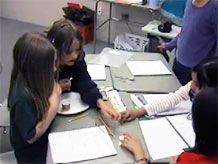What are things in my world made of?
2. Sort objects by materials
This is the heart of the investigation, the place where children make their thinking about materials explicit by sorting objects into groups according to their material properties. Encourage them by saying,
- Put the things together that are made of the same stuff.
- Make as many groups as you need, and give each group a name.
- Discuss your choices with your workmates.
You will likely hear a good deal of discussion about what constitutes "sameness." Are bright metals and dull metals the same? Should the plastic spoon be grouped with the plastic bag, even though one object is rigid and one is floppy? Students may also show some uncertainty about how to group objects made from more than one material. Remain neutral on these matters, asking the students what they think.

Some students may group objects according to their use rather than their material, e.g., putting the three spoons, the paper cup, and the plastic bag together as "kitchen stuff." Agree that this is one way of grouping the objects, but ask them to try doing it another way, putting things made of the same kind of stuff together. Give them time to try different groupings.
When students are satisfied with their groupings, they should record their findings in their notebook. If they created four groups, they should use four boxes. Students should include the following:
- Give each group a name or title.
- Use drawings or words to show what objects they put in each group.
Also encourage students to record any questions or ideas they have in their notebooks.



